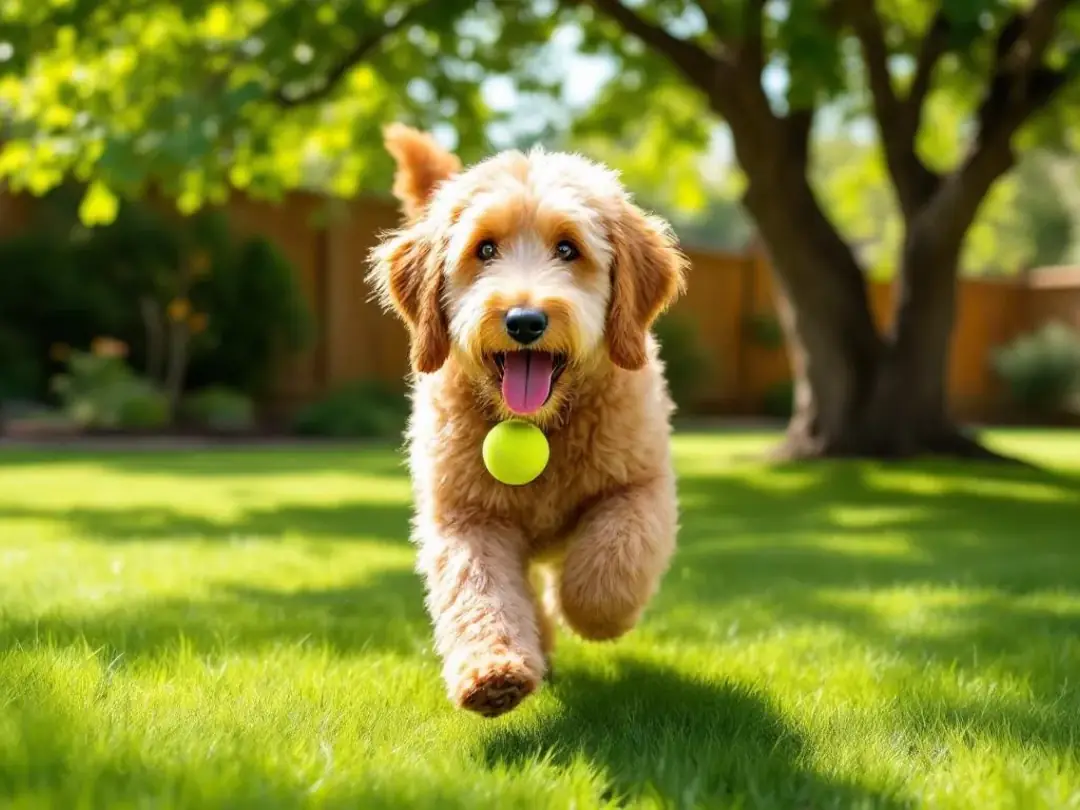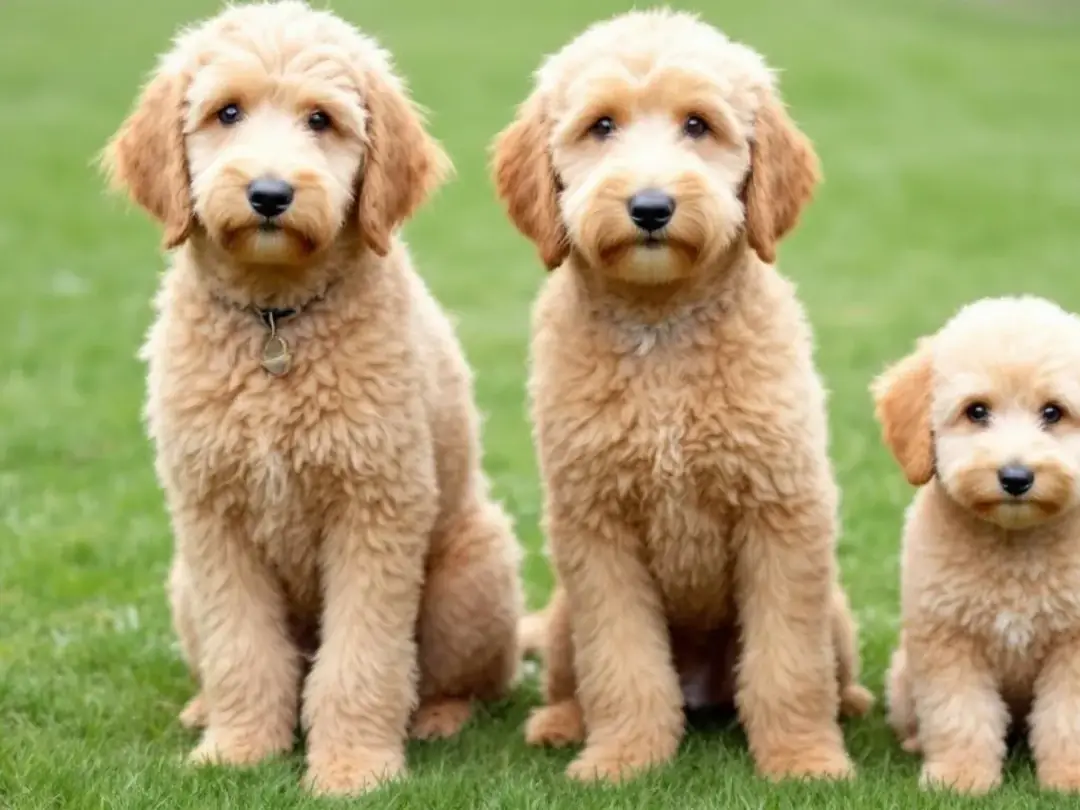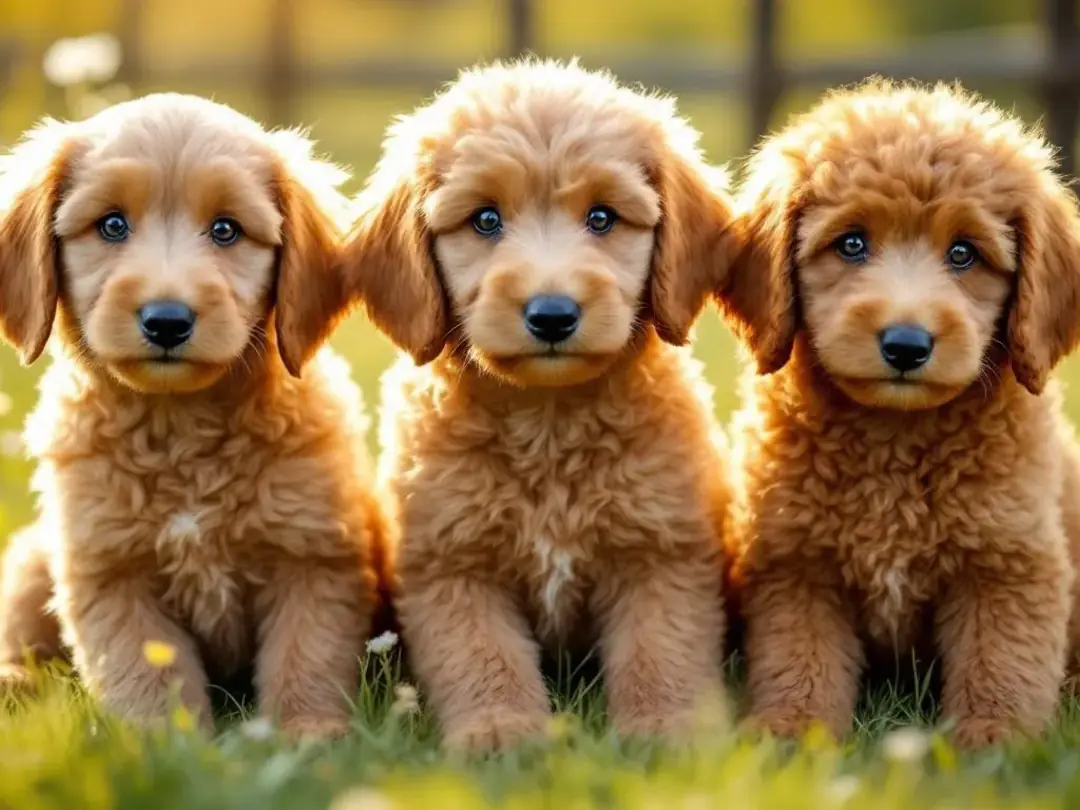Key Takeaways
-
Goldendoodles come in four main types: F1, F1B, F2, and Multigeneration, each with distinct genetic compositions and traits
-
F1B Goldendoodles (75% Poodle, 25% Golden Retriever) are typically the most hypoallergenic and least shedding
-
Coat type and shedding depend on furnishing genes rather than generation alone, making genetic testing more reliable than generation labels
-
All Goldendoodle types share similar temperaments but vary in coat texture, maintenance needs, and allergy-friendliness
-
Understanding these differences helps families choose the right Goldendoodle type for their lifestyle and allergy concerns
Introduction to Goldendoodles
Goldendoodles have quickly become one of the most sought-after hybrid breeds, thanks to their winning combination of the golden retriever's friendly nature and the poodle's intelligence. This unique blend makes goldendoodles excellent family pets, beloved for their affectionate personalities and adaptability to a variety of households. As a hybrid breed, goldendoodles inherit a range of coat types-from curly coats to wavy and even straight-each offering different levels of maintenance and hypoallergenic qualities.
Not all goldendoodles are the same, however. The different types of goldendoodles, known as generations, are defined by the specific mix of golden retriever and poodle genes in each dog. These goldendoodle generations play a big role in determining coat texture, shedding, and even how allergy-friendly your new companion might be. Understanding these differences is essential for anyone considering adding a goldendoodle to their family. In this complete guide, we'll break down the various goldendoodle generations, explore their unique coat types, and help you discover which type of goldendoodle is the perfect fit for your lifestyle.
Understanding Goldendoodle Generations
The "F" in goldendoodle generations stands for "filial," which simply means generation in breeding terms. When you see F1, F2, or F3, you're looking at how far removed that dog is from the original cross between a purebred golden retriever and a purebred poodle.
The "B" designation indicates a backcross, where a goldendoodle was bred back to one of the parent breeds-almost always a purebred poodle to enhance hypoallergenic qualities. This creates the F1B goldendoodle that many families with allergies specifically seek. There are different generations of Goldendoodles, such as F1 (first generation), F1B (first generation backcross), F2 (second generation), and multigen (multi-generational), each bred for specific traits like coat type, shedding, and appearance.
The Goldendoodle Association of North America (GANA) sets the standards for these classifications, helping bring consistency to what was once a confusing mix of breeder terminology. Their guidelines ensure that when a breeder says "F1B," you know exactly what genetic composition to expect.
Understanding these generation numbers helps you predict coat types, shedding levels, and grooming needs before you bring your goldendoodle puppy home. However, dna testing of the parent dogs can provide even more accurate predictions of coat types and shedding tendencies than generation labels alone.
F1 Goldendoodles (First Generation)
F1 goldendoodles represent the original cross-50% golden retriever and 50% purebred standard poodle. This generation brings the strongest hybrid vigor, meaning these dogs often enjoy better health and fewer genetic defects than their purebred parents.
The coat type in F1 goldendoodles varies significantly. Your puppy might inherit wavy coats that require moderate grooming, or you could end up with curlier coat textures that need professional attention every six weeks. Some F1 goldendoodles even display a relatively straight coat similar to their golden retriever parent.
Shedding levels in first generation crosses typically fall somewhere in the middle. Most F1 goldendoodles inherit one curl gene and one furnishing gene, creating a reduced shedding coat that's more allergy friendly than a golden retriever but not completely non shedding like many F1B goldendoodles.
These dogs make excellent family pets because they balance the best traits from both parent breeds without the extreme characteristics that can come from heavy backcrossing. If you want the classic goldendoodle experience with good health and don't mind some variability in coat texture, F1 goldendoodles offer a solid choice.
F1B Goldendoodles (First Generation Backcross)
When breeders cross an F1 goldendoodle back to a purebred poodle, the result is an F1B goldendoodle with roughly 75% poodle genes and 25% golden retriever genetics. This breeding strategy specifically targets families seeking the most hypoallergenic dog possible.
F1B goldendoodles have the highest probability of inheriting non shedding coats and curlier coat textures. The increased poodle genetics typically means these dogs inherit two furnishing genes, giving them the characteristic "teddy bear" face with longer facial hair and minimal shedding.
The trade-off comes in grooming requirements. F1B goldendoodles need professional grooming every 6-8 weeks to prevent matting, and daily brushing becomes essential for coat maintenance. Their curly coats trap loose hair instead of dropping it around your home, but that means more intensive grooming to keep them comfortable.
For families dealing with serious allergies, F1B goldendoodles represent the best compromise between the golden retriever temperament and poodle's hypoallergenic qualities. Just budget for regular grooming appointments-they're not optional with these curlier coat types.
F2 Goldendoodles (Second Generation)
F2 Goldendoodles are second-generation hybrids, produced by breeding two F1 Goldendoodles together, maintaining the 50% Golden Retriever and 50% Poodle genetic split. However, these second-generation crosses show the most unpredictable coat types and shedding patterns of any Goldendoodle generation.
The genetic lottery of F2 breeding means puppies in the same litter can vary widely in appearance and grooming needs. One puppy might inherit two furnishing genes and display minimal shedding with wavy coats, while a littermate could inherit zero furnishing genes and end up with a flat coat that sheds considerably more. Some F2 Goldendoodles may develop an improper coat, which lacks furnishings, tends to shed more, and is less desirable according to breed standards.
This unpredictability makes F2 Goldendoodles challenging for families with specific needs around allergies or grooming commitment. Some F2 Goldendoodles closely resemble their Golden Retriever ancestors with straight coat textures and higher shedding levels, while others lean toward the Poodle side with curlier coat patterns.
The appeal of F2 Goldendoodles lies in their genetic diversity and the possibility of getting lucky with ideal traits. However, if you need predictable hypoallergenic qualities or consistent grooming requirements, other generations offer more reliable outcomes.


Multigeneration Goldendoodles
Multigeneration goldendoodles, often labeled F3, F4, or simply "multigen," come from breeding goldendoodles to other goldendoodles beyond the F2 generation. Responsible breeders use these crosses to create more predictable traits through careful selection of parent dogs with desired characteristics.
The best multigeneration breeding programs focus on dogs with two furnishing genes, consistent coat types, and proven health testing. This selective approach can produce goldendoodles with reliable low shedding coats and predictable grooming needs, though it requires significant breeder expertise and genetic testing.
However, multigenerational goldendoodle breeding also reduces hybrid vigor compared to F1 and F1B generations. As you move further from the original cross between purebred parents, the health advantages of genetic diversity begin to diminish, making careful selection of breeding dogs essential.
Quality multigen goldendoodles from experienced breeders who prioritize health testing can offer the most consistent coat characteristics. Poor multigen breeding, however, can concentrate genetic problems, so breeder selection becomes critical with these later generations.
Flat Coated Goldendoodles
Flat coated goldendoodles are a unique variation within the breed, known for their smooth faces and coats that closely resemble those of a purebred golden retriever. Unlike the classic goldendoodle look, which features longer facial hair and a plush, teddy bear appearance, flat coated goldendoodles lack the furnishing genes inherited from the poodle parent. This means they don't develop the signature eyebrows, mustache, and beard that many goldendoodle lovers expect.
Flat coated goldendoodles are often produced when an F1 goldendoodle is bred back to a golden retriever, reducing the likelihood of passing on the furnishing genes. As a result, these dogs tend to shed more than their furnished counterparts and may not offer the same hypoallergenic qualities that make goldendoodles popular with allergy-sensitive families. However, for those who appreciate the classic look and temperament of a golden retriever but want some of the hybrid vigor and personality of a goldendoodle, flat coated goldendoodles can be a wonderful choice.
While they may require more frequent cleaning to manage shedding, flat coated goldendoodles still bring the friendly, loving nature and intelligence that both golden retrievers and goldendoodles are known for. If you don't mind a bit of extra hair around the house and are drawn to the smooth, sleek look, this type of goldendoodle could be the right companion for your family.
Coat Genetics and Characteristics
Understanding coat genetics takes the guesswork out of choosing goldendoodle types. Three main genes determine your dog's final coat characteristics: furnishing genes, curl genes, and coat length genes.
The furnishing gene (F gene) controls facial hair and directly links to shedding levels. Dogs with two furnishing genes typically have a non shedding curly coats as a classic amongst the types of goldendoodle hair waves and with longer facial hair, while dogs with zero furnishing genes shed more and have smooth faces similar to golden retrievers.
Curl genes (KRT71) determine coat texture from straight to tightly curled. A dog can inherit anywhere from zero to two curl genes, creating the spectrum from flat coated goldendoodles to dogs with extremely curly coats requiring intensive grooming.
Length genes (FGF5) affect overall coat length. Dogs with the dominant FGF5 gene will have a long coat, while those with two copies of the recessive gene will have a short coat. The difference between a long coat and a short coat is determined by these specific genes, which influence both the dog's appearance and grooming needs.
Furnished vs Unfurnished Coats
Furnished coats display the classic goldendoodle look with longer facial hair forming eyebrows, mustache, and beard. These dogs typically inherit the low shedding characteristics that make goldendoodles popular with families managing allergies.
Unfurnished coats lack the facial hair and more closely resemble the flat coat of a golden retriever. These goldendoodles often shed more significantly and may not provide the hypoallergenic qualities many families seek.
The furnishing gene is dominant, meaning a dog only needs one copy to display furnished characteristics. However, dogs with two furnishing genes typically show more pronounced facial hair and lower shedding levels than dogs with just one copy.
Smart breeders conduct genetic testing for furnishing genes rather than relying on generation labels alone. This breeder tests approach provides much more accurate predictions about adult coat characteristics than appearance-based guessing.


Size Variations Across Types
All goldendoodle types come in multiple sizes determined by the poodle parent. Standard goldendoodles, bred from standard poodles, typically weigh 50-90 pounds and suit families with active lifestyles and larger living spaces.
Medium goldendoodles, crossing with medium poodles, usually range from 30-45 pounds. This size offers a sweet spot for many families-substantial enough for outdoor adventures but manageable for most living situations.
Miniature goldendoodles result from breeding with miniature poodles and typically weigh 15-30 pounds. These smaller dogs work well for apartment living and families seeking a more portable companion, though they often retain the same energy levels as their larger counterparts.
Some breeders also offer toy goldendoodles from toy poodle crosses, weighing 10-25 pounds. These tiny goldendoodles require careful selection to avoid the fragility issues that can affect very small dogs.
Size doesn't change the fundamental characteristics of each generation-an F1B miniature goldendoodle still carries the same 75% poodle genetics and hypoallergenic potential as a standard F1B, just in a smaller package.
Color and Pattern Variations
Goldendoodle colors span the combined palette of both parent breeds. From the golden retriever side, you'll see cream, golden, apricot, and red tones. Poodle genetics add black, chocolate, silver, gray, and cafe au lait possibilities.
Special patterns create even more variety. Parti goldendoodles display large patches of two colors, while phantom patterns show specific markings similar to a Doberman's coloring. Abstract patterns feature random white markings, and merle patterns create a mottled appearance.
Color inheritance follows complex genetic rules that don't correlate with generation type. An F1 goldendoodle might be solid black, while an F1B from the same breeding program could be cream-the generation number doesn't predict color outcomes.
Some colors, particularly the lighter shades, may fade or change as your goldendoodle puppy matures. This color shifting is normal and doesn't indicate any health issues or breeding problems.
Choosing the Right Type for Your Family
Your lifestyle needs should drive your choice between different types of goldendoodles, not marketing claims or adorable puppy photos. Start by honestly assessing your family's allergy sensitivity, grooming budget, and time commitment. Understanding these factors will help you find the perfect Goldendoodle for your family.
For families with severe allergies, F1B goldendoodles offer the best odds of truly hypoallergenic qualities, though individual puppy genetics matter more than generation labels. Request furnishing gene testing results from any breeder you're considering.
Consider your grooming commitment carefully. Curly coats require professional grooming every 6-8 weeks plus daily brushing to prevent matting. Wavy coats need less intensive care but still require regular attention. Straight coat goldendoodles may shed more but need minimal professional grooming.
Budget impacts extend beyond the initial puppy price. F1B and multigen goldendoodles with curlier coat textures carry ongoing grooming costs that can reach $100-150 per session depending on your location and the dog's size.
Energy levels and space requirements remain similar across all goldendoodle types. These dogs inherit active lifestyles from both parent breeds and need mental stimulation and physical exercise regardless of their genetic composition.


Finding Reputable Breeders
GANA-approved breeders follow ethical breeding practices and maintain health testing standards that protect both parent dogs and puppies. Look for breeders who provide genetic testing results for furnishing genes, curl genes, and common health conditions affecting both parent breeds.
Ask specific questions about the breeding dogs' health clearances. Responsible breeders test for hip dysplasia, elbow dysplasia, eye conditions, and heart problems. They should provide documentation of these tests and explain how they select breeding pairs. It is also important to ensure that breeding dogs are not closely related, as this helps maintain genetic diversity and reduces the risk of inherited health problems.
Red flags include breeders who can't explain their genetic testing protocols, refuse to show you the parent dogs, or make unrealistic promises about adult characteristics. Avoid operations that always have puppies available or pressure you to decide quickly.
Price ranges vary significantly by region and breeder reputation, but expect to pay $1,500-$3,000 for a well-bred goldendoodle from health-tested parents. F1B goldendoodles and smaller sizes often command premium prices due to higher demand.
Quality breeders offer health guarantees covering genetic conditions for at least two years. They also provide ongoing support and will take the dog back if circumstances change, showing their commitment to the puppies they produce.
FAQ
Which Goldendoodle type sheds the least?
F1B goldendoodles typically shed the least because they're 75% poodle and have the highest chance of inheriting two furnishing genes. However, genetic testing is more reliable than generation alone for predicting shedding levels. Some F1 and F2 goldendoodles with favorable genetics may shed less than poorly-bred F1B dogs.
Are F2 Goldendoodles harder to predict than other types?
Yes, F2 goldendoodles are the most unpredictable because puppies can inherit varying combinations of genes from their F1 parents, resulting in widely different coat types and shedding levels even within the same litter. You might get anything from a flat coat that sheds significantly to a curly coat that barely sheds at all.
Do all Goldendoodle types have the same temperament?
Generally yes-all goldendoodle types inherit the friendly, intelligent, and loyal temperament from both parent breeds. Personality differences are more individual than generation-based, though energy levels may vary slightly. The golden retriever's gentle nature and the poodle's intelligence create consistent temperament traits across all generations.
Is hybrid vigor present in all Goldendoodle generations?
Hybrid vigor is strongest in F1 goldendoodles and can persist in F1B crosses. It gradually decreases in F2 and subsequent generations, which is why responsible breeding practices become increasingly important for health. Multigeneration goldendoodles have the least hybrid vigor, making careful selection of breeding dogs with good health essential.
Can you predict adult coat type from puppy coat?
Puppy coats often change significantly as dogs mature, making prediction difficult. Professional genetic testing for furnishing, curl, and length genes provides much more accurate predictions than appearance alone. A puppy with a relatively straight coat might develop waves as an adult, while some curly puppies maintain their texture throughout life.
Conclusion
Choosing the right goldendoodle comes down to understanding the unique characteristics of each generation, coat type, and the needs of your family. Whether you're drawn to the hypoallergenic qualities of an F1B goldendoodle, the classic look of a flat coated goldendoodle, or the genetic diversity of an F2 or multigen, there's a goldendoodle out there to match your lifestyle and preferences.
Remember, not all goldendoodles are created equal. Factors like furnishing genes, curl gene, and careful breeding play a much bigger role in coat type and shedding than generation labels alone. Take the time to research reputable breeders, ask about genetic testing, and consider your grooming commitment before bringing home your new goldendoodle puppy.
With the right knowledge and preparation, you'll find a goldendoodle that brings joy, companionship, and a touch of golden retriever charm to your family for years to come.






